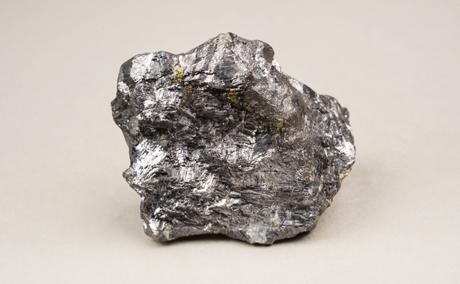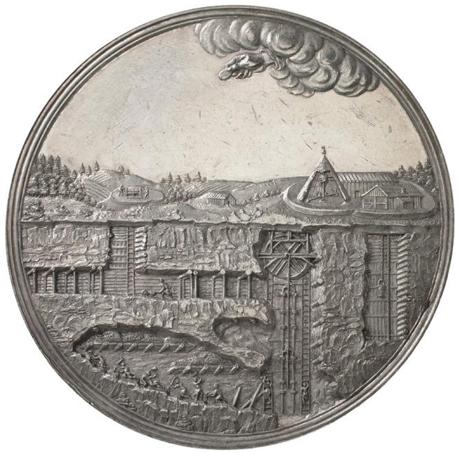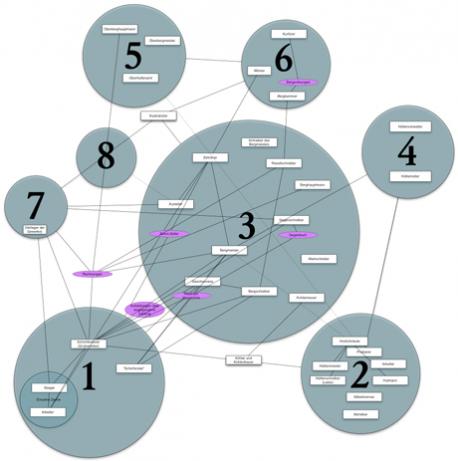Metal mining is among the earliest contexts in which large technical systems emerged that had a need for reliable inputs of labor, capital, and materials. However, the behavior of workers and investors was often as unpredictable as the “behavior” of metal-bearing veins in the rock. In my project, I investigate how people in seventeenth and eighteenth-century Saxony—an important and globally-connected mining region in central Europe—responded to this marked uncertainty of the business. Which observations counted as reliable data? How were relevant experiences stored and standardized for later use? Whose expertise was valued, and whose rejected?
The epistemic interaction between the different stakeholders—organized as they were in work teams, companies, scientific societies, and state administrations—was complicated, and rife with tensions. Absentee investors were not always persuaded by the arguments of local administrators that low yields were a sign of promise rather than ruin. Underpaid workers with little loyalty to the mine might have had the best direct knowledge of how hard the rock was or where groundwater pressed in. Academics could be ridiculed as impractical men, yet the need for systematic exploration, based on their knowledge of new, more predictive theories of ore formation, became obvious to many. By comparing and contrasting commercial book-keeping and scientific and administrative “fact-keeping,” this project contributes to a broadening discussion about the ways in which individuals and groups used information technology—paper-based or otherwise—to engage with a complex social and natural environment.

Fig. 2: This piece of galenite, a silver ore common in Saxony, belonged to the collection of the eminent eighteenth-century mineralogist Abraham Gottlob Werner. TU Bergakademie Freiberg, Geowissenschaftliche Sammlungen, Inv.-Nr. 108610. Photography: Susanne Paskoff.
The complexity of the environment was a consequence of the activity itself, as metal mining had an “in-built” tendency to grow in scale and depth. Initially, people could find rich veins in brittle rock close to the surface, which were mined profitably with simple tools. When they dug deeper, however, deposits became poorer, while more sophisticated technology was needed for their extraction. Heavy machinery was built to lift people and materials, and air was pumped into unnatural depths; water was gathered to push wheels and help drain the lower galleries. Costly process architectures emerged in order to move the ore from the rock, to crush it, and to melt the metal out of the dust. The need for coordinating the various works necessary in underground mines created an environment in which bureaucratic routines—clusters of regulated practices that dovetailed the efforts of different people with different roles—could emerge and thrive. The wheels, pumps, and shafts were thus just the more externally visible components of systems of coordinated labor, in which actors sought to stabilize inputs and outputs and turn the “gamble” of the early days into a source of income as reliable as farming; pooling capital became as much an object of planning as pooling water. The emergence of routines inflects the above question of reliable data, information storage and relevant expertise in many ways, as the knowledge production in mining administrations often had different objectives and timescales to those of individuals or more loosely organized groups of miners. By telling this history without recourse to a narrative of top-down rationalization, this project contributes to ongoing efforts to understand how formal organizations emerged from organized action.

Fig. 3: This commemorative silver medal marked the completion of an aquaduct (shown on the obverse) as well as the first payment of a dividend after years of loss. Münzkabinett, Staatliche Museen zu Berlin, Inv. Nr. 18207762. Photography: Lutz-Jürgen Lübke.
By the end of the sixteenth century, Saxon mining was supervised by a four-level administration with local workers instructed by foremen, regional mining offices as well as a central mining office, and the government in Dresden. This makes it an unusually clear example of how physical structures and bureaucratic routines coevolved: as the mines penetrated into deeper regions of the earth, the administration penetrated deeper into the organization of the work carried out by local teams. This, however, quickly gave rise to a tension between the need for large-scale planning on the one hand, and the intensely local nature of mining on the other. How could decision makers “higher up” tap into the knowledge “on the ground” that was necessary for their planning, and how could a central plan be made to work across very different local situations? As a solution to this problem, routines were set up and perpetuated that linked knowledge production and decision-making in specific ways. Historians can detect these routines by paying close attention to how experiential data were created, evaluated, transformed, and moved around when people went about their work in the office or in the mine. From analyzing these interactions a picture emerges in which smaller semi-autonomous cycles of data generation and decision-making were nested into larger ones. Mining thus resembled a curious machine whose different parts worked independently yet “watch[ed] one another,” as a late eighteenth-century official put it, allowing a course of action to crystallize slowly across a network of observers and decision makers.

Fig. 4: Visualization of relationships between roles (white), artifacts (magenta) and organized bodies (grey) as they are mentioned in the Saxon Mining Ordinance of 1589. (1 Individual mines, 2 Smelting works, 3 Local Mining Office, 4 Central Smelting Office, 5 Central Mining Office, 6 Government, 7 Owner-Investors, 8 Town Councils)
The regular inspection of a mine (Generalbefahrung) is a good example of this nested process, as it linked various levels of the hierarchy, different groups of actors, and a host of information technologies in order to produce decisions about what work teams should do next. Finding promising spots for exploration and extraction was a continuous challenge, especially in the region’s complicated geology. Every Tuesday, the district directors (Bergmeister), assessors and surveyors left the various Mining Offices across Saxony, and were joined by the local foremen at the entrance of a mine and given an oral report. Workers showed them where they had noticed veins during their daily work. The officials would recall reports about ongoing and planned works, yield figures, and numbers of workers while the surveyor put the promising spots on a (mental) map. Mineral samples were investigated, based on vernacular or academic theories about ore formation. When eventually a decision was made, it was ascribed to the Bergmeister who formally assumed responsibility for it. However, the process by which alternatives were constructed, evaluated, chosen, and rejected can be more accurately understood as a case of distributed cognition, in which different actors contributed different steps in processing a complex environment. Autonomous thinking by all parties was encouraged as long as, paradoxically, it concurred in a decision about how labor time was used in the mine.
Such a decision in turn created a very concrete environment—for example, a particular site for making an exploration dig—in which nature was experienced (or believed, desired, anticipated) to respond to human action. By showing how different financial, administrative, and scientific ways of constructing a relevant environment could converge in action, this study will thus deepen our understanding of how the natural environment is a social, and indeed a historical, category.
